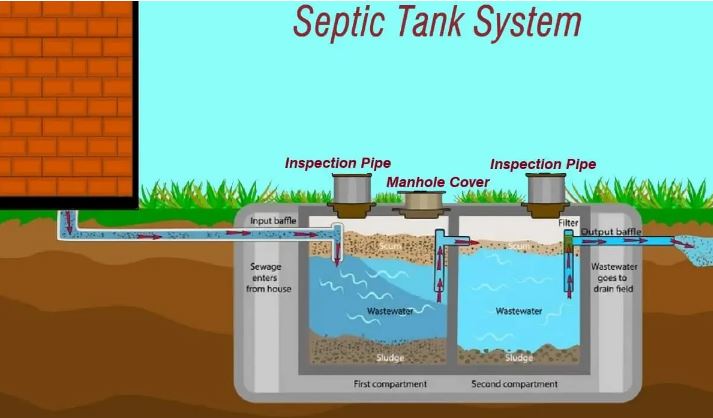Homeowners in the US are facing unprecedented difficulties with their septic systems. Industry insiders are quick to place blame for septic system failures on powdered laundry detergents, high rainfall, and cheap toilet paper. This article addresses each problem in order.
Aging septic systems in the US and around the globe are being hit by attacks from numerous sources. The combination of these factors has led to incredible numbers of septic system problems. Fortunately for homeowners, the sources of their septic tank issues are easy for experts to identify. Industry insiders point to several problem areas, each of which has contributed to the rising rate of septic tank issues. The issues range from obvious – heavy rains – to surprising – phosphate-free detergents. The goal of this article is to review each of the major problem areas and, when possible, suggest how to avoid them.
Reformulated Detergents and your Septic System
Phosphate-free detergents are gaining popularity for their environmentally-friendly cachet. These detergents have their own problems: they don’t clean as well as traditional detergents. However, they do not seem to contribute to septic system issues. Rather, it is the powdered detergents that cause the most harm. Powdered laundry detergents can quickly clog a septic tank due to the high volume of undissolved solids.
It may seem like cheap powdered detergents are a good way to save money, but beware: many of these products contain inactive fillers that do nothing but clog up your system over time. Make sure to read the product’s label to search for these fillers. Undissolved solids from powdered laundry detergents accumulate in septic systems. The more frequently such solids enter the system, the more frequently the septic tank will need to be pumped.
In addition to using liquid detergents, homeowners should reduce the load on their septic systems – literally. Minimizing the number of laundry loads will prolong the life of a septic system. Along with each load of laundry comes up to 53 gallons of wastewater, which can quickly stress a septic system[1]. Combine laundry loads and switch to low-flow appliances whenever possible to extend the life of your system.
Toilet Paper and Septic Systems
Since toilet paper flushes directly into septic systems, it makes sense to make the effort to choose a septic tank safe brand of toilet paper. Contrary to popular belief, dyed and/or scented toilet papers are not any worse for septic systems than ordinary varieties. Fortunately for those who prefer comfort, the NSF (National Sanitation Foundation) has found that toilet paper thickness does not affect septic system functioning[2].
To ensure that your toilet paper is septic system safe, choose only septic tank safe brands. These brands should be labelled as such. Many brands have been evaluated by the NSF and will bear the foundation’s seal somewhere on the packaging. Though you may be safe using a non-approved brand of toilet paper, the risk of septic tank backup is not worth the small monetary savings. Low quality toilet paper may fail to dissolve, and instead accumulate in your system.
A final note on the toilet-septic tank link: never flush anything other than waste or toilet paper! Facial tissues and other household refuse are not designed to dissolve and will simply clog up your system, resulting in toilet backups.
A Septic Tank is not a Garbage Can
There is a near-endless list of substances that should be kept out of septic tanks. Rather than spending hours poring over this list, you can extend your septic tank’s useful life by remembering a simple phrase: a septic tank is not a garbage can. Anything that doesn’t come out of your body (other than toilet paper) should not go down the sink. Some of the biggest kitchen culprits are fats, grease, coffee grinds, cigarette butts, and paper towels.
Don’t flush hazardous chemicals down your sink, either. Septic systems are not designed to handle these chemicals. Problem substances include paint, varnish, paint thinner, and pesticides. Dispose of these chemicals according to the instructions on the product label rather than pouring them into the sink. Even in small amounts, these chemicals can disrupt the digestion process that is supposed to occur in septic tanks.
The final warning of this segment may come as unwelcome news to some homeowners: garbage disposals clog septic systems. In fact, using a garbage disposal can increase the amount of undissolved solids in your septic system by up to 50 percent. The simple fact is that using a garbage disposal means you will need to pump out your septic tank more frequently.
Rain and your Septic System
Septic tank problems after heavy rain are a common complaint. Very heavy rains can flood the soil surrounding the septic tank. The problem arises when the water level rises above the drain field trench. When this happens, the drain field quickly becomes saturated. Once the drain field is completely saturated, household water no longer has a place to drain. This leads to a backup, and ultimately the waste water will flow to the area of least resistance. This may mean that the waste water flows back into your basement or wherever else it can go. This situation also leads to large volumes of untreated wastewater flowing into the groundwater and local streams, which may cause serious environmental problems.
Keep your system pumped and in good shape before flooding occurs to help minimize septic issues after rains. During storms, minimize your usage of water to keep the load on your septic tank as low as possible. If you notice that the drainfield is completely covered with water, do not use your septic system at all. Be careful around this standing water, as it may contain untreated sewage. If you begin to notice that drains are not draining quickly, toilets flush slowly or make strange sounds, or water is backing up into your basement, your septic system is under significant stress.

You can also design your house in such a way as to minimize runoff water and keep the soil from getting saturated. Make sure all gutters drain away from the septic tank, and keep rain gutters clear of debris. Plant only grass above the system. In addition, make sure that all electrical components are water-proofed. This can protect your system from damage during rainfall and prevent any electrical shocks.
Finally, make sure to keep your system in good condition. This means regularly pumping your septic tank. Most tanks need to be pumped every 3 to 5 years. The more people who live in your house, and the smaller your tank is, the more frequently it will need to be pumped.


